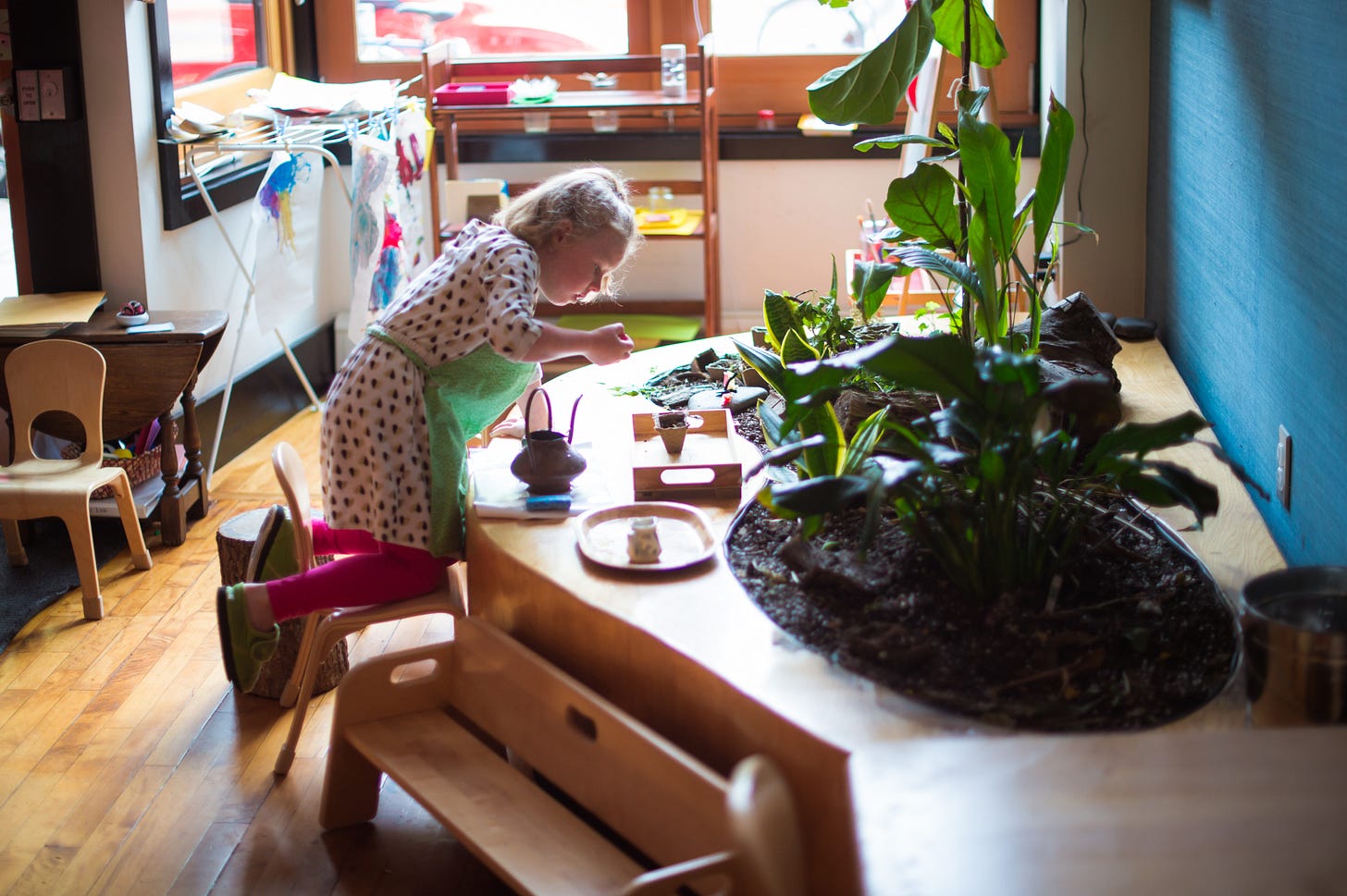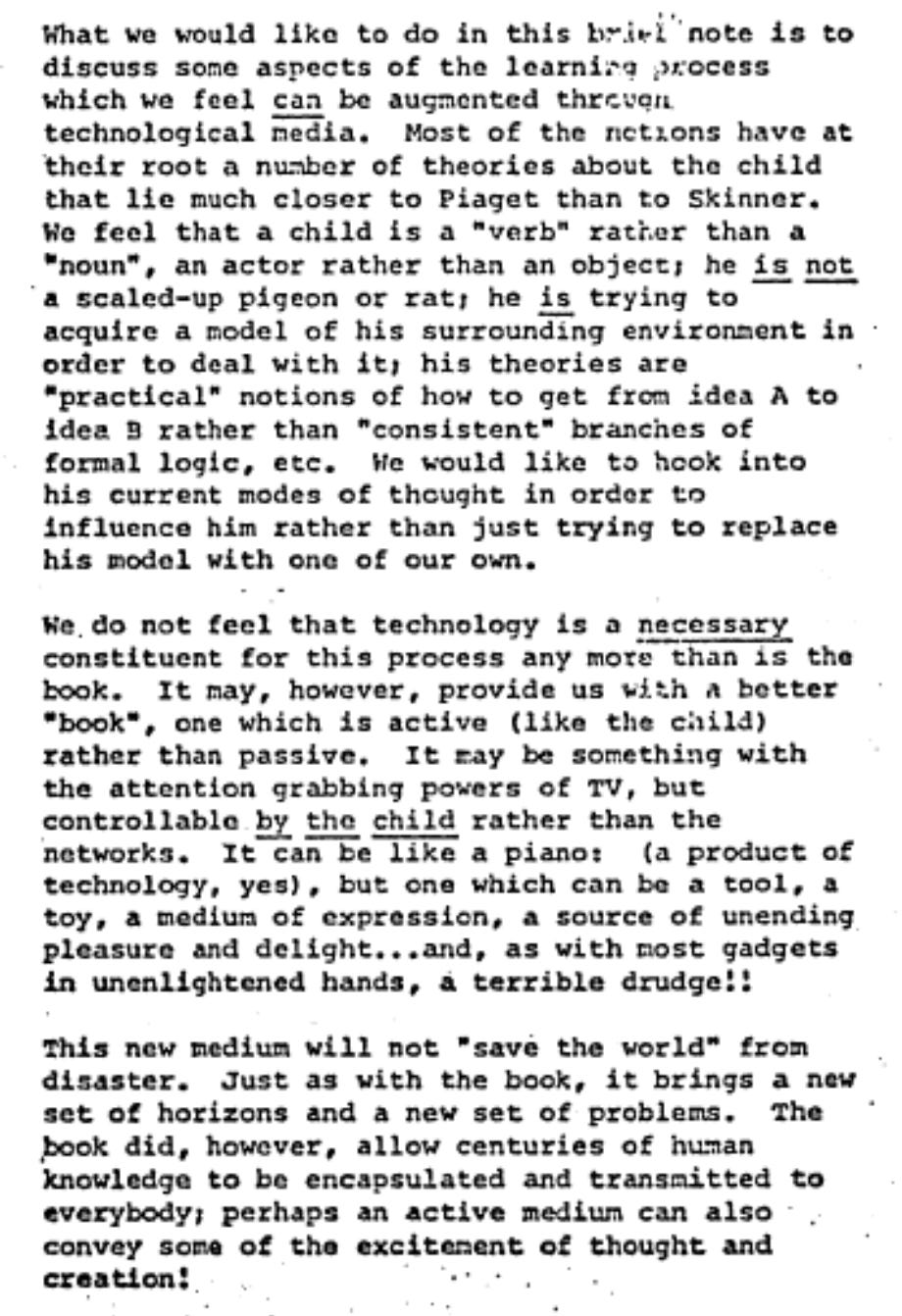Papert, Montessori, and building the future of education and tech
Some of our most transformative technology has roots in Montessori via Papert. Some thoughts on why.
Seymour Papert and his colleagues fundamentally transformed how many of us experience computers and the internet. Take for example Google. Larry Page was advised by Terry Winograd, one of Seymour's students. Great advisors help students work on the right problem. In this case, Terry encouraged Page to work on the problem that led to Google.1
Apple's roots are even closer to Seymour: Steve Jobs publicly points to Xerox PARC and Alan Kay's work as the foundations for Apple's innovations.2 Many tech geeks know this. But what many don't know is that Alan Kay had a similar moment when he visited Seymour and his colleagues in Boston. Watching children create in LOGO profoundly impacted Kay.3
Why was Seymour's research so different from prevailing ideas about computers, children, and learning? And why were people profoundly impacted by it?
Prior to MIT, Seymour worked closely with Jean Piaget, a legendary Swiss psychologist who led Switzerland's Montessori society. These experiences led Seymour to work on problems different from mainstream technologists. Instead of building teaching machines, he created contexts for children to construct knowledge as they might in a Montessori or Reggio environment.4

In contrast, most research and work in education and in creative tools remains trapped within industrial paradigms for thinking about learning, knowledge, and human development. This becomes glaringly obvious when we examine the questions that researchers and technologists ask when building new tools or school models, something we’ll get into in a later post.
If you're trying to change the game in education or build transformative tools for thought, I'd recommend pausing on the Cog Sci stuff you were reading and pick up Montessori or Malaguzzi.5 Spend time in a Montessori or Reggio school and just observe. How kids move around the space. How they work alone and with others. The materials they interact with. And the role of the guides in designing the environment, curating materials, and supporting the children as guides and collaborators.
I suspect that doing so would likely change the questions you ask — and lead you to build very different kinds of tools or communities. And the world would likely be better for it.
Notes
Larry Page on working with Terry Winograd:
“I had sort of researched all the people I could work with and I was surprised that there was basically nobody else in the world who I wanted to work with besides Terry,” Page said at the 20th anniversary celebration of Stanford’s HCI program. “He was a really solid computer scientist, he understood that side — but he also had a great passion around something that I wanted to work on that I thought was very important, which was HCI, something almost nobody else seemed to get. I think that’s still true. I’m amazed that people think computers are about computers and not about people.”
Page brought Winograd at least 10 different ideas for a dissertation topic, including self-driving cars and telepresence, both of which Google is now pursuing quite seriously. But both were beyond the resources of a graduate student, no matter how talented. Then Page got interested in search.
“At some point I woke up and I decided it would be easy, really easy, to download the Web, the entire Web, and just keep the links,” Page recalls. “Terry said, ‘Yeah, that’s a good one, go and do that.’… I’m very indebted to him.”
Steve Jobs describing the impact of seeing the Xerox Alto, work led by Alan Kay and others:
See Rheingold's Tools for Thought for one account of Seymour's impact on Kay. For example:
When [Alan Kay] came across the LOGO work, during the time he was meditating about the fact that he had put two years into the FLEX machine only to find that it wasn't amenable to humans who tried to use it, Alan Kay recalls that "it was like a light going on in my head. I knew I would never design another program that was not set up for children."
One of the first things he understood was that a program or a programming language that can be learned by children doesn't have to be a "toy." The toy can also serve as a tool. But that transformation doesn't happen naturally -- it comes about through a great deal of work by the person who designs the language. Kay already knew that the most important tools for creating personal computing were to be found in the software, but now it dawned on him that the power those tools would amplify would be the power to learn -- whether the user is a child, a computer systems designer, or an artificial intelligence program.
Although he knew he had a monstrous software task ahead of him if he was to create a means by which even children could use computers as a simulation tool, his FLEX experience and his exposure to LOGO convinced Kay that there was far more to it than just building an easy-to-operate computer and creating a new kind of computer language. It was something akin to the problem of building a tool that a child could use to build a sandcastle, but would be equally useful to architects who wanted to erect skyscrapers. What he had in mind was an altogether new kind of artifact: If he ended up with something an eight-year-old could carry in one hand and use to communicate music, words, pictures, and to consult museums and libraries, would the device be perceived as a tool or as a toy?
Also see Alan Kay's A Personal Computer for Children of All Ages.
Cog sci ideas are powerful. Things like spaced, interleaved practice, elaboration, and far transfer are powerful ideas. But they need to live within a broader architecture.
For more, see the following post:
Placing Cog Sci ideas within a broader 'Learning' Architecture




